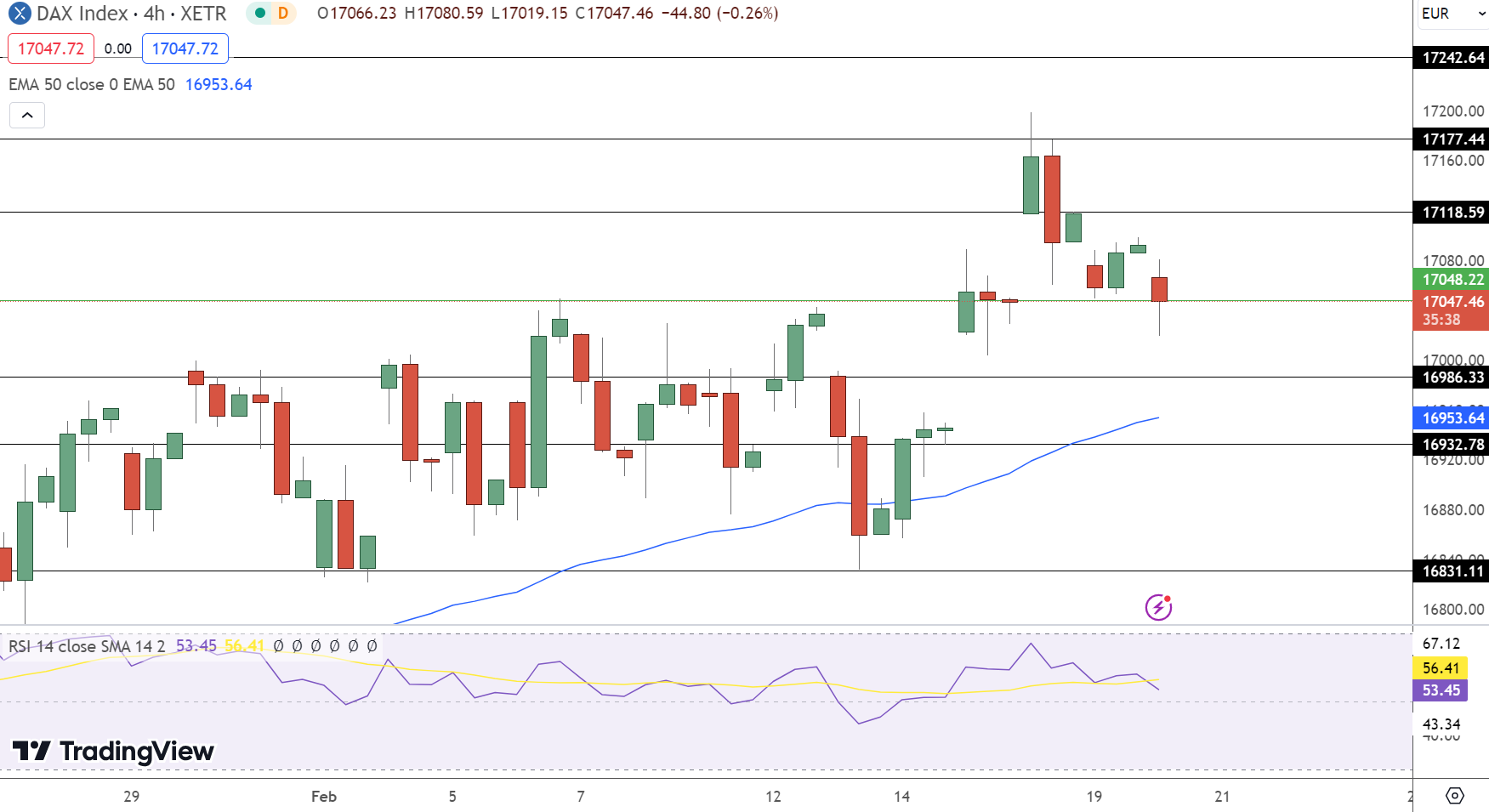DAX Price Forecast Hits 17,098 Amid French Growth Cut & Global Tensions

The DAX index experienced a slight decline of 0.15% on Tuesday, closing at 17,098 points. However, several factors that raised investor concerns contributed to this decline. However, the reason behind this downward rally was the revision of growth forecasts for France, which were lowered from 1.4% to 1.0% for the year 2024.
Meanwhile, geopolitical tensions such as the conflicts in Gaza and Ukraine, as well as weakened trade terms with China and Germany, have played a major role in undermining the DAX index.
Furthermore, the recent GDP numbers from Germany indicating a potential economic recession added to the pressure on the DAX index.
These macroeconomic conditions, coupled with uncertainties surrounding the European Central Bank’s (ECB) interest rate policies, impacted buyer demand for DAX-listed stocks, particularly in sectors such as retail and automotive.
ECB Stance, German Data, and European Market Impact
It is worth noting that the current situation surrounding the European Central Bank (ECB) and its monetary policy is impacting the stock market.
This is why market participants are closely observing the ECB’s decisions regarding interest rates and stimulus measures, with speculation mounting about a potential interest rate cut in April 2024. This speculation reflects concerns about economic growth and inflation.
Moreover, recent economic data from Germany, particularly highlighted in the Bundesbank Monthly Report, indicates a projected decline in inflation rates.
Despite positive indicators such as the rise in European Union passenger car registrations, concerns persist about the overall economic outlook in the Eurozone. Any hints from the ECB regarding its monetary policy decisions could significantly impact the performance of the DAX index and broader European markets.
Geopolitical Issues in the Middle East and Their Impact
On the flip side, the geopolitical tensions in the Middle East, particularly the ongoing conflicts involving Israel, Hamas, and Hezbollah, have undermined global markets, including the DAX index.
However, the escalating violence and humanitarian concerns have raised apprehensions among investors, contributing to market volatility.
Therefore, the potential for further escalation in the region poses a significant risk factor for the DAX index, particularly given Europe’s geopolitical ties and economic interests in the Middle East.
Federal Reserve, US Economy, and Impact on the DAX Index
On the US front, the Federal Reserve’s monetary policy decisions and the performance of the US economy also play a crucial role in shaping the direction of the DAX index. With the US markets reopening after the President’s Day holiday, attention is focused on indicators such as the US CB Leading Economic Index and commentary from Federal Open Market Committee (FOMC) members.
Meanwhile, concerns about weak consumer confidence and the economic outlook in the US could influence market sentiment and investor risk appetite, impacting global equity markets, including the DAX index.
Furthermore, the indications of a delay in Fed rate cuts or diverging monetary policies between the US and Europe could further contribute to market volatility and affect the performance of the DAX index in the near term.
DAX Technical Outlook
In the intricate dance of global finance, Germany’s DAX index serves as a barometer for European economic health and investor sentiment. The daily crypto markets, with their rapid movements and volatile nature, often mirror the broader trends seen in traditional markets like the DAX.
Today, the DAX has experienced a slight retreat, closing at 17047.46, a modest decline of 0.27%. This movement reflects the cautious optimism and underlying uncertainties that characterize the current market environment.

At the heart of technical analysis are the key price levels that act as signposts for traders and analysts alike. The pivot point for the DAX stands at 17048.22, a critical juncture that the index narrowly undershot.
Resistance levels at 17118.59, 17177.44, and 17242.64 delineate potential ceilings for upward movement, each marking a step further into bullish territory. Conversely, support levels at 16986.33, 16932.78, and 16831.11 form a safety net below which market sentiment could shift from cautious optimism to concern.
The Relative Strength Index (RSI) for the DAX is currently at 53, indicating a market that is neither overbought nor oversold, but rather in a state of equilibrium. This suggests that investors are weighing their options, with no clear consensus on the market’s direction.
Additionally, the 50-day Exponential Moving Average (EMA) at 16953.64 provides a baseline for the index’s short-term trend.
| Broker | Website | |
|---|---|---|
| 🥇 |  | Visit Broker >> |
| 🥈 |  | Visit Broker >> |
| 🥉 |  | Visit Broker >> |
| 4 |  | Visit Broker >> |
| 5 |  | Visit Broker >> |
| 6 |  | Visit Broker >> |
| 7 |  | Visit Broker >> |











